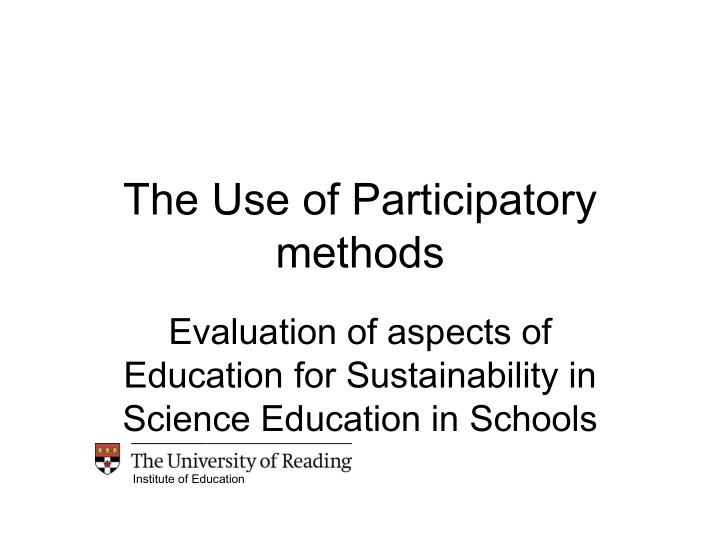



The Use of Participatory methods Evaluation of aspects of Education for Sustainability in Science Education in Schools Institute of Education
What are participatory methods of evaluation? • Reason, P. & Bradbury, H. 2001 A Handbook of of action research: participatory inquiry and practice. London: Sage. • Heron, J. 1996 Co-operative inquiry: research into the human condition. London: Sage. • Fals-Borda, O & Rahman, M.A. 1991 Action and knowledge: breaking the monopoly with PAR. London Apex and Intermediate Technology Press • Chambers, R. 1992 Rural appraisal: rapid relaxed and participatory. IDS Bulletin, 311.
Considerations when using Participatory Methods Assume that: - • Practitioners understand the nature of their professional problems or needs. • A group of practitioners collectively have most of the ideas and practical experience to solve their problems. • Practitioners have few opportunities for reflection in their day to day work. • Practitioners value the ideas and experience of other practitioners who work in the same context.
The Role of the Evaluator when using Participatory approaches The evaluator should: - • not function as an expert • take the role of facilitator • encourage reflection • provide additional inputs when requested or when the need is apparent
The Advantages of using Participatory methods 1. They are relevant to the needs of the practitioners 2. They encourage teamwork and collaboration 3. They can lead to empowerment 4. They help to break down social and status barriers that may exist 5. They work well with groups of professionals who share the same or similar working contexts
Problems with EfS in the Science Curriculum of Schools • The curriculum is already overloaded • Lack of clarity about sustainability • Many of the major ideas are complex • Concerns about indoctrination of students about EfS • EfS is multidisciplinary • Many of the major issues cause alarm and despondency • The controversial nature of the issues • Difficult to make this part of the curriculum coherent
Some of the main outcomes from the research • Identification of the contribution that science education can make to EfS within the whole curriculum • The development of particular teaching methodologies • Participatory methods leading to action research
The Contribution of science education to EfS • Learning new vocabulary and scientific explanations • Seeking information from different sources • Carrying out first-hand enquiries • Making judgements about what constitutes evidence or opinion • Communicating information • Understanding the limitations of scientific knowledge • Understanding that scientific knowledge is provisional
Outline of an Action Research Project arising from participatory methods Aims (what are we trying to achieve?) ↓ Decision (how can we achieve it practically? Answer, base it on a waste management project) ↓ Identification of resources and methodologies needed ↓ Implementation including monitoring ↓ Collection of results, analysis and outcomes ↓ Evaluation against original aims
Materials used in home and school • Biodegradable • Non-biodegradable Compost NB most non- Alternative biodegradable materials controlled that become waste require means. a large input of energy for Eg Sewage, extraction of raw materials use of animal or harvesting and or plant wastes subsequent manufacture as fertiliser.
Materials used in home and school • Recyclable • Non-recyclable (recycling results in Disposal Re-use/repair less energy compared to manufacture from Incineration Landfill basic materials) metals glass plastic paper/card clothing and fabrics
More detail of waste management opportunities Materials used in the home and school Biodegradable Non-biodegradable (N.B. most non-biodegradable materials that become waste require a large input of Alternative controlled energy for extraction of raw materials or Compost means e.g. sewage use of harvesting and subsequent manufacture) animal or plant wastes as fertiliser Recyclable Non-recyclable (recycling results in less energy expended compared to manufacture from basic materials) metals glass plastic paper/card clothing fabrics Disposal Re-use/repair Incineration Landfill
The results of monitoring the relative amounts of each type of material collected Paper and Glass (bottles Metal Plastic cardboard and jars) (aluminium (bottles) and steel cans) Week 1 57 17 17 10 Week 2 61 12 18 9 Week 3 60 13 18 10 Week 4 53 15 16 15 Average 57.75 14.25 17.25 11 Results are expressed as a percentage of the weekly collection by weight Percentages are rounded up or down to the nearest whole number and therefore may not equal 100% The overall weight of materials in week 4, when most materials were collected, was 11.5% more than in week 2, when least was collected.
Environmental Impacts Local Safety (eg glass bottles, dangerous chemicals) Water pollution (eg oil or chemicals) Air pollution (particles and chemicals from incineration) Soil pollution (from landfill) Subsidence and erosion from landfill Aesthetic from discarded paper, plastics and other materials
Environmental Impacts Regional Water and air pollution becomes regional problems as pollutants carried in air and water currents. Transporting waste materials for disposal causes air pollution and leads to global warming.
Environmental Impacts Global Lack of recycling, re-use and repair means that more materials are needed at primary sources, in distant environments. Requiring more extraction and harvesting. Thus more energy require, depletion of resources and removal of habitats. Also, the requirement for more manufacture of goods, leading to the need for more energy and creating more pollution.
The issues related to sustainability identified by a group of teachers
The Benefits of Participatory Action Research methods • More likely to address the needs of practitioners • Can result in practitioner empowerment • Has a strong motivating effect on those involved • Breaks down barriers between researchers and practitioners • Encourages practitioners to evaluate and reflect on practice
Recommend
More recommend